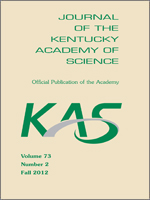The pawpaw (Asimina triloba) is a native understory tree of 26 states of the Eastern and Midwestern United States. Pawpaw's genetic diversity and clonality in relation to this tree's ability to compete with local invasive species in Kentucky has not been examined. The objectives of this study were two-fold: to determine the genetic diversity and clonality displayed in seven native pawpaw patches located at the Kentucky State University Environmental Education Center (KSU-EEC), The Kentucky River, Cove Spring Park, and the KSU Research and Demonstration Farm in Franklin County using DNA microsatellite markers; and to determine if patches reduced the incidence of invasive species. Twenty-five trees from seven patches in the four different locations were sampled for genetic analysis. Leaf samples were extracted using the DNAmite Plant Extraction Kit and products from four microsatellite loci were analyzed using a 3130 Applied Biosystems Gene sequencer. String grids were created and invasive plants counted in three 5 meter squares in each of the patches and control plots outside of each patch. The number of plants for each invasive species within pawpaw patches was counted and compared to the control plots. Pawpaw patches displayed high genetic diversity among populations with some clonal sections in patches using DNA microsatellite makers, but no totally clonal patches. Amur honeysuckle (Lonicera maackii), garlic mustard (Alliaria petiolata), and winter creeper (Euonymus fortunei) were found in most locations; however, there was no significant difference in the incidence of invasive plants between the patches and the control plots. Pawpaw stem density and shading, among other factors may be important in the incidence of invasive plants within patches.
How to translate text using browser tools
1 September 2012
Pawpaw Patch Genetic Diversity, and Clonality, and its Impact on the Establishment of Invasive Species in the Forest Understory
Jacob Botkins,
Kirk W. Pomper,
Jeremiah D. Lowe,
Sheri B. Crabtree
ACCESS THE FULL ARTICLE
Amur honeysuckle
Asimina triloba (L) Dunal
forest understory
genetic diversity
invasive species
Kentucky State University
KSU





